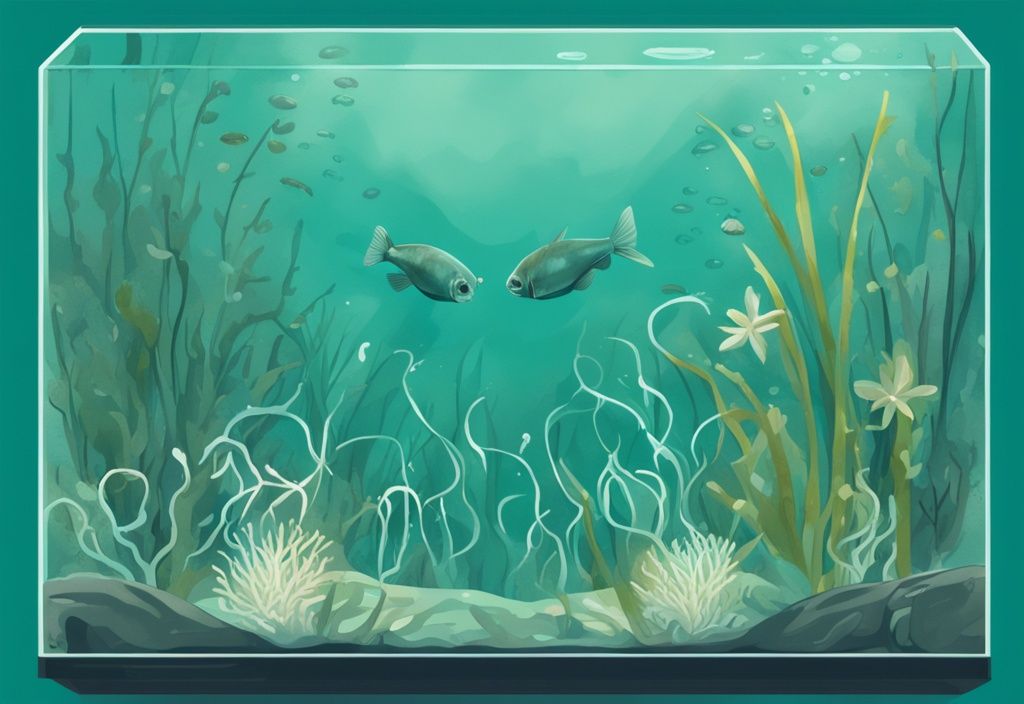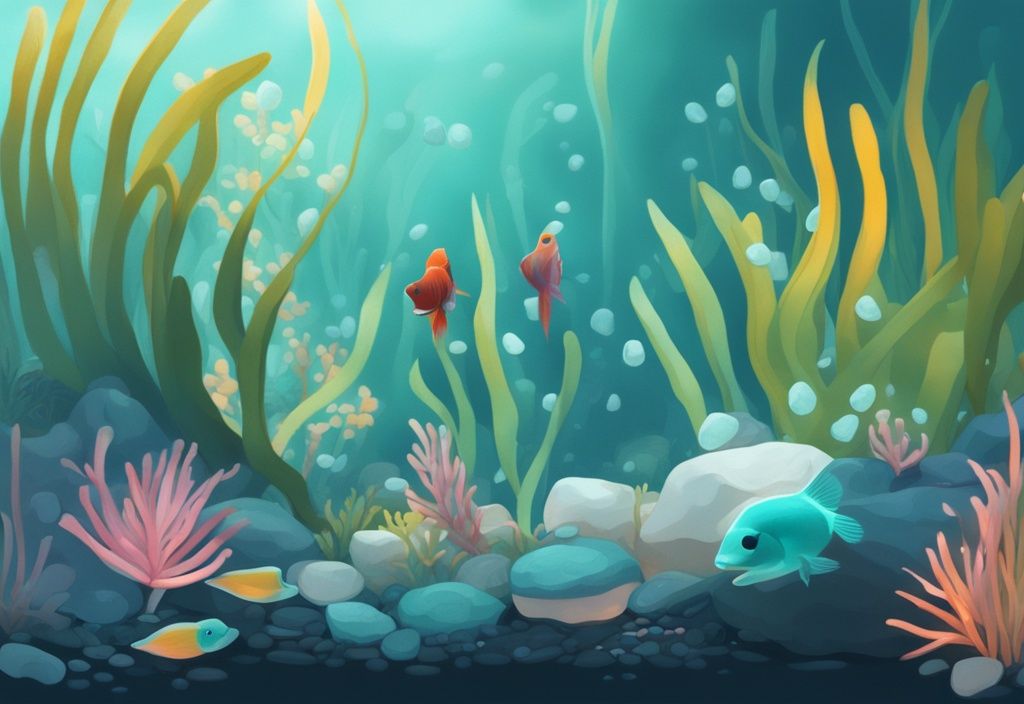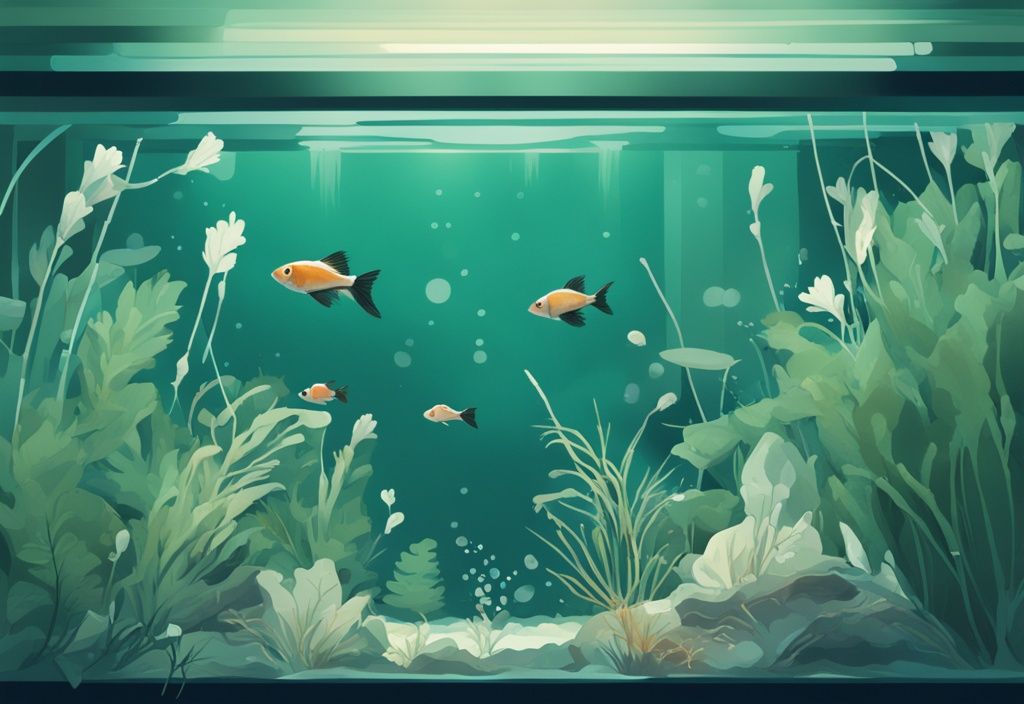Has your aquarium transformed into a squirming stage for tiny white worms lately? As a seasoned marine biologist, I understand the heart-stopping moment of spotting these minuscule invaders. Rest assured, we’re going to tackle this together.
Did you know these barely-visible bandits could put your finned friends and your vibrant underwater ecosystem at risk? Our focus here is to help you identify and understand the different types of these tiny white creatures infesting the tank’s tranquility.
We’ll explore effective and sustainable strategies for their eradication while illuminating the common underlying causes of their presence. Armed with this information, you’ll become adept at keeping a worm-free aquarium, ensuring a healthy, thriving habitat for your aquatic pets.
What are These Tiny White Worms in Your Aquarium?
Aquarium enthusiasts often encounter tiny white worms in their tanks, which can be unsettling. These tiny white worms in aquariums typically fall into three main categories: Detritus Worms, Rhabdocoela Worms, and Planaria Worms. Properly identifying these worms is crucial for addressing the situation effectively, as misidentification can lead to inappropriate and ineffective treatments.
Correct identification of tiny white worms in your aquarium is the first step to resolving the issue. Detritus Worms, often appearing as thin, thread-like creatures, are commonly found in gravel and feed on decomposing organic material.
Conversely, Rhabdocoela Worms are smaller, flat, and move slowly, often mistaken for other types of undesirable pests. Meanwhile, Planaria Worms, characterized by their triangular heads and eyespots, can pose a danger to fish eggs and weakened fish due to their carnivorous nature.
Misidentifying these tiny white worms can result in using the wrong treatment approach. For instance, applying a treatment meant for Planaria Worms to an infestation of harmless Detritus Worms not only fails to solve the problem but also could negatively impact the aquarium’s ecosystem.
Effective solutions require understanding the precise kind of worm present. Moreover, misuse of dewormers can have dire consequences. Many dewormers contain potent chemicals that, if used incorrectly, can harm or even kill the fish and other aquarium inhabitants.
Therefore, it is imperative to identify the worms accurately and choose suitable treatment methods. This preventive approach ensures the well-being of your aquatic pets while maintaining a healthy and balanced aquarium environment.
An In-depth Look into Different Types of Aquarium Worms
Aquarium worms come in various forms, each with distinct traits and roles in your tank’s ecosystem. Understanding these differences is vital for maintaining a balanced and healthy environment. Let’s explore three common types of tiny white worms you might encounter in your aquarium: detritus worms, planaria worms, and rhabdocoela worms.
Detritus Worms: Description and Identification
Detritus worms are segmented annelid worms, which may remind you of earthworms or tubifex worms. These tiny white worms in aquariums often appear as thin, pointy, white-brown strings. They primarily feed on decomposing plant and animal waste, effectively acting as little sanitation workers in your tank.
Introduced into the aquarium through new fish, plants, or gravel, detritus worms usually reside within the substrate, helping to keep it clean. However, an overpopulation of these worms can signal poor tank maintenance or overfeeding. They may emerge from the gravel due to low oxygen levels or an acidic environment, hinting at potential underlying issues.
Despite their alarming numbers at times, detritus worms are a natural and beneficial part of the aquarium ecosystem, not posing a threat to your fish or shrimp under normal conditions.
Planaria Worms: What to Look For
Planaria worms, a type of flatworm from the class Turbellaria, often attach themselves to pond plants. They are easily identifiable by their distinct eyespots and widened heads with characteristic protrusions. Fascinatingly, these worms can reproduce asexually and regenerate from fragments, adding to their resilience.
As scavengers and carnivores, planaria can be a threat to fish eggs and weakened fish. Therefore, noticing these tiny white worms in your aquarium early on is crucial for taking timely actions to control their population and ensure a healthy environment.
Rhabdocoela Worms: Spot the Differences
Rhabdocoela worms belong to the Rhabditophora class and are another type of tiny white worm found in aquariums. Unlike the segmented detritus worms, rhabdocoela worms are smaller and non-segmented. They move slowly, relying on mucus for locomotion rather than swimming.

These worms primarily feed on algae, decaying plants, and leftover fish food. While mostly beneficial, an overpopulation of rhabdocoela worms can necessitate better tank maintenance. Understanding these differences helps accurately identify the worms in your aquarium and take the right steps to manage their presence.
Understanding Causes of Aquarium Worm Infestations
Aquarium enthusiasts often encounter tiny white worms in their tanks, leading to concerns about their origins and impacts. Properly identifying the root causes of these infestations is crucial for maintaining a healthy aquarium environment.
One of the primary causes of tiny white worm infestations in aquariums is overfeeding. Overfeeding leads to an excess of organic waste, which serves as a food source for worms like Detritus Worms and Rhabdocoela Worms. These worms thrive on the leftover food and decomposing matter, resulting in rapid population growth.
Another key factor is poor tank maintenance and infrequent cleaning. Neglecting regular tank upkeep allows organic debris to accumulate, creating a favorable environment for worm proliferation. Regular cleaning and substrate vacuuming are essential to remove detritus and prevent worm outbreaks. For those looking for effective maintenance tools, consider checking out our best fish tank gravel cleaner review to find the right equipment for your needs.
Lack of proper filtration and oxygenation can also contribute to worm infestations. Effective filtration systems help to remove organic waste and prevent it from settling, while proper oxygenation ensures a healthy environment for fish, making it less hospitable for worms to breed and grow.
Introduction of worms through new plants, fish, or substrate is another common cause. When bringing new elements into the aquarium, it is crucial to quarantine and thoroughly inspect them for any signs of worms or other pests to prevent inadvertent contamination.
Lastly, breakdowns in organic matter like plants, fish, or substrate can lead to an increase in tiny white worms in your aquarium. As organic matter decays, it releases nutrients that worms feed on, thereby fueling their populations.
By understanding these causes, aquarium owners can take proactive steps to prevent and manage worm infestations, ensuring a healthier and more vibrant aquarium ecosystem.
Essential Management Techniques for Controlling Detritus Worms
Cleaning Your Aquarium: Best Practices
Keeping your aquarium clean is fundamental in managing detritus worms, those pesky tiny white worms in aquariums. Regularly using a gravel vacuum to thoroughly clean the tank is crucial. This process helps remove excess waste and uneaten food particles that could otherwise contribute to worm proliferation.
Pay special attention to the substrate where detritus worms commonly reside. Maintaining a consistent cleaning schedule ensures that waste buildup is kept to a minimum, which directly impacts the worm population and the overall health of your aquarium.
Importance of Regular Filtration System Checks
A well-functioning filtration system is essential for maintaining a healthy aquarium environment, thus preventing infestations of tiny white worms in aquariums. Regularly inspect your filtration system to ensure it’s working efficiently and not clogged. Address any issues promptly to guarantee that organic waste is properly filtered out.
Increasing surface agitation through methods such as adding a spray bar can significantly enhance oxygenation in the tank. Proper oxygen levels deter detritus worms from surfacing, thereby keeping their population under control.
Reevaluating Your Feeding Practices
One of the primary causes of detritus worm overpopulation is overfeeding. It’s important to adjust feeding practices to match the dietary needs of your fish, reducing the amount of food introduced into the tank. Observing your fish during feeding times will help you gauge the appropriate amount they can consume within a few minutes.
Reducing uneaten food will limit the organic waste that detritus worms feed on, thereby helping to keep their numbers in check and ensuring a cleaner and healthier aquarium environment.
How to Manage Oxygen Levels to Prevent Worm Infestation
Maintaining adequate oxygen levels in your aquarium is another vital step in managing worm infestations. Adding an air stone can significantly improve the dissolved oxygen in the water.
Additionally, increasing surface agitation through water movement enhances gas exchange, preventing oxygen levels from dropping. Proper oxygenation ensures that detritus worms remain within the substrate rather than surfacing, thus making it easier to manage their population and maintain a balanced ecosystem within your aquarium.

Practical Tips to Control and Eliminate Planaria Worms
Detecting and managing planaria, those pesky tiny white worms in your aquarium, is essential for maintaining a healthy aquatic environment. This guide offers you a detailed approach to identifying, removing, and treating planaria to ensure your tank thrives.
How to Verify Planaria Presence: Key Indicators
Detecting planaria in your aquarium requires careful inspection. These tiny white worms can often be seen gliding smoothly across surfaces. One of the most distinct identifiers is their flat bodies featuring eyespots and triangular heads. It’s crucial to ensure you’re dealing with planaria before initiating any treatment, as misidentification can lead to unnecessary actions that might stress your fish without addressing the actual problem.
Manual Removal Techniques That Work
For effective control of planaria, manual removal is often the first step. You can physically pluck these worms from the tank using tools like tweezers, ensuring you handle the worms gently to avoid leaving behind pieces that could regenerate.
Additionally, performing salt or freshwater dips on affected fish can help eradicate worms clinging to their bodies. It’s a practical and immediate response to seeing planaria in your tank.
Make Safe Use of Dewormers
When physical methods alone aren’t sufficient, dewormers serve as a potent second line of defense. Always follow the manufacturer’s guidelines meticulously to avoid dosing errors that could harm your aquarium’s ecosystem. Consulting a veterinarian before using any deworming medications ensures that you are applying the safest and most effective treatment for your specific tank conditions.
Misuse can be detrimental, so professional advice is essential.
Ensuring Safety of Vulnerable Fish Species During Deworming
Deworming treatments can have adverse effects on sensitive species like snails, shrimp, and scaleless fish. To mitigate risks, temporarily remove these vulnerable inhabitants to a safe holding tank during the treatment process. Adhering to the safety guidelines is paramount to protect all aquarium residents, ensuring that the elimination of tiny white worms like planaria doesn’t come at the cost of your fish’s safety.
Effective Strategies to Handle Rhabdocoela Worm Infestations
Maintaining a balanced and healthy aquarium is essential, especially when dealing with tiny white worms, also known as Rhabdocoela worms. Implementing a few strategic practices can help manage these infestations effectively while promoting a thriving aquatic environment.
The Role of Regular Substrate Vacuuming
Regular substrate vacuuming is integral in managing the population of tiny white worms in your aquarium. By thoroughly cleaning the substrate, you significantly reduce the organic waste that serves as a food source for Rhabdocoela worms. Consistent vacuuming not only helps in removing these worms but also promotes a healthier tank environment, minimizing the risk of overpopulation. Imagine it as giving your aquarium a deep-clean – it’s essential for maintaining a clean and balanced habitat for your aquatic friends.
Keeping Leftover Food to a Minimum
Minimizing leftover food is crucial in preventing Rhabdocoela worm infestations. Overfeeding your fish can result in excess uneaten food, which decomposes and creates perfect conditions for these tiny white worms in the aquarium to thrive. It’s vital to feed fish sparingly and promptly remove any uneaten food. This practice not only controls worm populations but also maintains overall tank cleanliness and fish health. Think of it as a step towards a healthier diet for your fish, ensuring they get just enough without any excess.
Consider Predator Fish as a Control Measure
Introducing predatory fish can be a natural and effective control measure for Rhabdocoela worm infestations. Certain fish species are known to feed on these tiny white worms, helping to keep their numbers in check. However, it’s important to closely monitor tank dynamics to ensure that the new fish integrate well without causing stress to existing inhabitants. This method not only controls worm populations but also adds diversity to your aquarium. Picture it as adding a new member to the family – it requires some adjustment but can be highly beneficial.
Using Chemicals Safely for Worm Control
Chemical treatments should be your last resort for controlling Rhabdocoela worm infestations. When opting for deworming chemicals, it’s essential to follow the manufacturer’s guidelines meticulously to avoid harming fish and other tank inhabitants. Consultation with a veterinarian can provide additional safety assurances. Responsible chemical use ensures effective worm management while maintaining a safe and healthy aquarium environment. Think of it as using medicine – it can be incredibly effective when used correctly but requires careful handling.
Implementing these strategies with a careful and balanced approach ensures that your aquarium remains a vibrant and healthy ecosystem, free from the nuisance of tiny white worms.
Preventing Future Worm Infestations: Essential Tips
When it comes to averting the nuisance of worm infestations in your aquarium, adopting a few critical practices can make all the difference. Let’s dive into the essentials for maintaining a worm-free tank environment.
Regular Checks and Maintenance to Stay Worm-free
Maintaining consistent tank upkeep is crucial for preventing worm infestations. Regular checks and cleaning of the tank, including the substrate and glass, help eliminate potential habitats for tiny white worms in your aquarium. This also involves monitoring the aquarium for any signs of worms and taking immediate action if any are detected. Consistently cleaning the tank will remove debris and excess organic matter that worms feed on, ensuring a healthier environment for your fish.

The Role of Water Quality in Worm Infestation
High water quality is essential in reducing the worm population in your aquarium. Tiny white worms in an aquarium often thrive in poor water conditions. Regularly testing and maintaining acceptable water parameters, such as pH, ammonia, nitrite, and nitrate levels, can prevent the conditions that favor worm proliferation. Proper filtration and periodic water changes are also integral in keeping the water pristine and unsuitable for worm growth, ultimately supporting a balanced and healthy aquatic ecosystem.
The Impact of Overfeeding on Worm Infestation
Overfeeding is a common culprit behind worm infestations. Excess food decomposes and becomes organic waste, providing ample nutrition for tiny white worms in the aquarium. To combat this, feed your fish appropriate amounts and avoid leaving uneaten food in the tank. Portion control and removal of leftover food can significantly reduce the organic matter that worms feed on, thereby keeping their population under control. Monitoring feeding habits ensures a healthy diet for your fish without contributing to worm issues.
The Importance of Frequent Water Changes
Frequent water changes are imperative for maintaining water quality and preventing worm infestations. By regularly replacing a portion of the aquarium water, you can remove potential worm eggs and organic waste from the tank. This not only helps in keeping the water clean but also disrupts any breeding cycles of tiny white worms in your aquarium. Performing consistent water changes ensures that the environment remains inhospitable to worms while benefiting the overall health of your aquarium’s inhabitants.
FAQ
Are Tiny White Worms in Aquarium Harmful to Fish?
- Not all tiny white worms in aquariums are harmful; only planaria pose a direct danger to your fish.
- Detritus and Rhabdocoela worms, however, are generally not harmful to fish and can coexist peacefully.
How Do I Distinguish Different Types of Aquarium Worms?
- Detritus worms: These are thin, thread-like, and exhibit active movement, wriggling through the water.
- Rhabdocoela worms: You’ll notice they are flat, small, and move slowly, with distinctive round ends.
- Planaria worms: They have triangular heads, clear eyespots, and glide smoothly across surfaces.
Can Overfeeding Trigger Worm Infestations in Tanks?
- Absolutely. Overfeeding can lead to excess organic waste, which in turn promotes worm infestations in your aquarium.
How Should I Respond If Planaria Worms Invade My Tank?
- First, confirm their presence by carefully observing the tiny white worms in your aquarium.
- Then, use manual removal techniques along with safe deworming treatments to eradicate them.
- It’s crucial to remove vulnerable species during the treatment process to ensure their safety.
Are Chemical Treatments Safe for Worm Removal in Aquariums?
- Chemical treatments can be effective but should only be used as a last resort to avoid potential harm.
- Always follow the manufacturer’s instructions meticulously to prevent any adverse effects on your fish.
- Moreover, consulting with a veterinarian before using chemical treatments is highly recommended.
